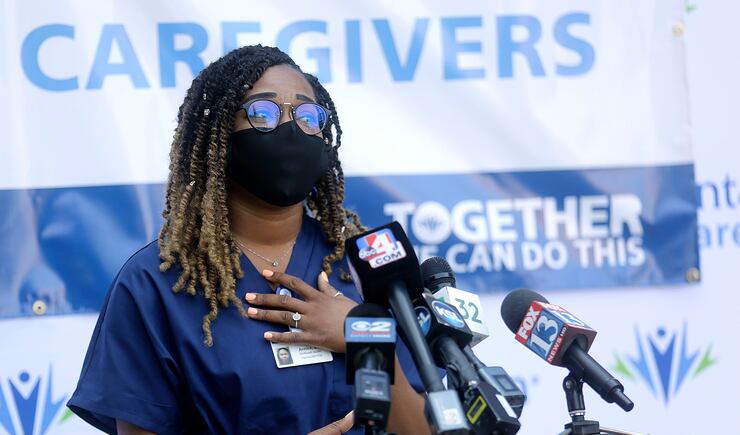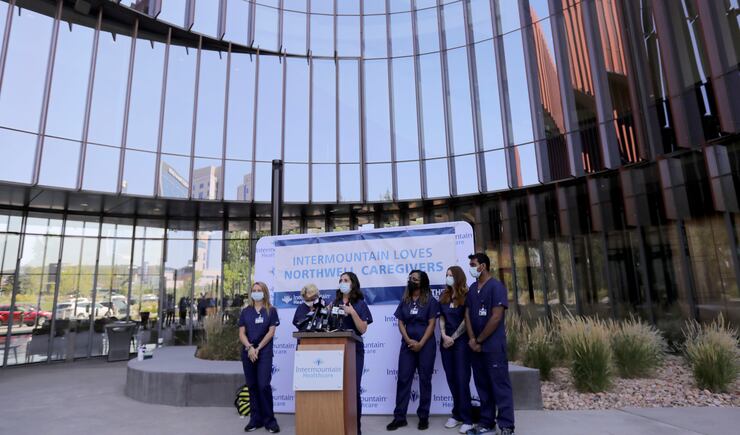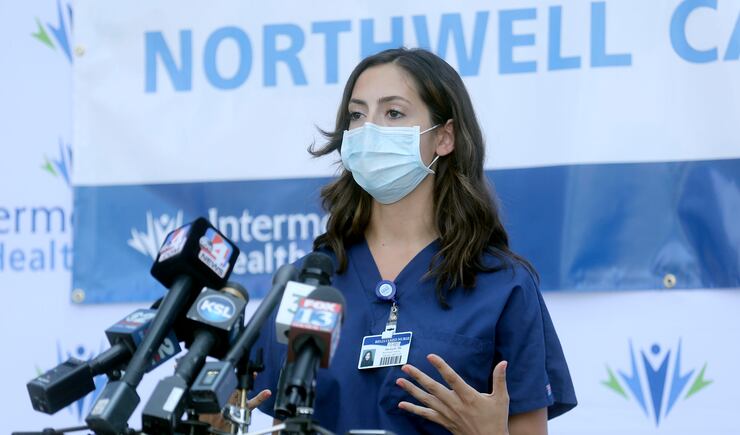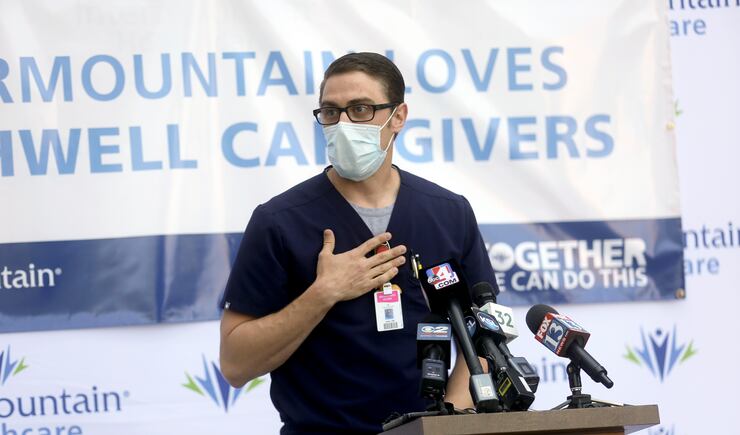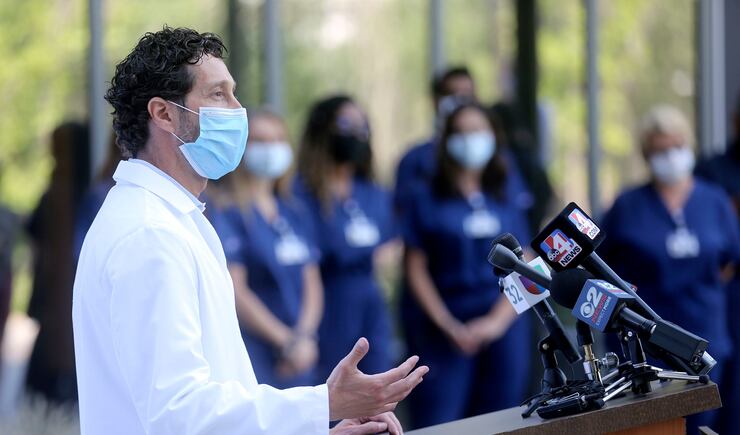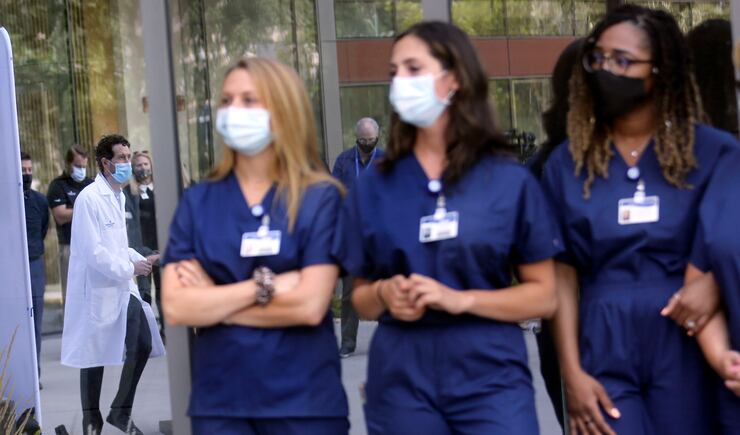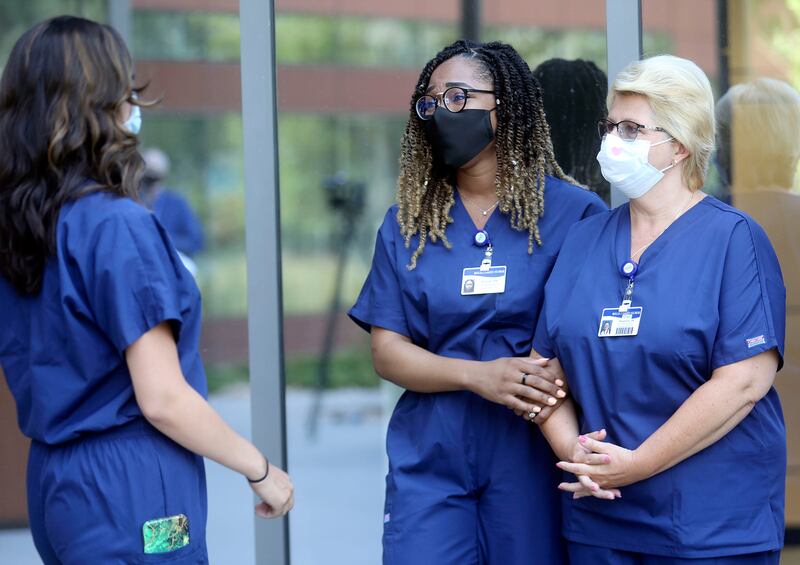SALT LAKE CITY — As Utah is seeing a plateau in new COVID-19 cases, New York City nurses who fought one of the world’s largest COVID-19 outbreaks are now in the Beehive State to share their expertise with Intermountain Healthcare providers.
When Intermountain physicians and nurses earlier this year traveled to New York City during the peak of its battle against the disease, as the city was losing hundreds of lives a day, a partnership developed between Utah’s largest health care system and Northwell Health.
Dr. Paul Krakovitz, chief medical officer for specialty-based care, called that friendship a “bright spot” in the pandemic. Northwell Health has treated more than 70,000 COVID-19 patients — more than any other system in the country — “which is a real, incredible amount of expertise that they’ve developed,” Krakovitz said.
Though Utah is not experiencing a surge, Krakovitz noted, the relative calm is an ideal time to learn from the New York nurses. Thirty intensive care nurses from Northwell Health will travel to Utah, 10 of whom are here now and spoke to reporters on Tuesday.
“This will give us an incredible way to collaborate,” Krakovitz said.
When New York City’s hospital systems became overwhelmed with coronavirus patients, the nurses said they were facing double or triple their normal workload, each caring for four to six patients rather than two, as they normally would.
Adara Abrahamsen said she came to Utah because “I feel I need to give back. You guys came and helped us when things were really picking up, and there’s no words to describe the things that we’ve seen and we’ve gone through. And it’s really important to give back to your team.”
“We were going home exhausted,” said Annice Sterling, describing the peak of the pandemic in New York as “going to war” rather than work. Like Abrahamsen, Sterling said she decided to come to Utah to give back to the Intermountain nurses.
“That to me was the most amazing thing they could do when we had no idea what was going on, and everything was a fight.”
But they have since gotten an upper hand on the disease in that city, the nurses noted. Improvements in care have been made as providers have learned more about the disease.
At the beginning of the pandemic, doctors weren’t able to give patients certain oxygen therapies, including nasal cannula, a device used to increase airflow to a patient, and BiPAP, which is a mode of respiratory ventilation, as they would cause aerosolized COVID-19 particles to enter the air, said Shereyah Barbera, Northwell nurse. That is why so many patients required intubation, which is normally a last resort, she said.
But the use of negative pressure rooms have allowed doctors to provide those oxygen therapies, which has now “prevented a lot of intubations,” which come with risks to patients including pneumonia, Barbera said. Without being intubated, patients are also able to remain self-prone, meaning they can roll themselves over in bed, which makes a “big difference.”
The nurses agreed their role has changed during the pandemic as, due to visitor restrictions, they have also needed to become patients’ emotional support.
“We are learning more and more about how to change this very complex disease,” said Dr. Dixie Harris, an Intermountain critical care physician who traveled from Utah to New York earlier this year as part of the exchange. She said she was “very excited” for providers at Intermountain to learn more from the New York nurses.
Tuesday case counts
Utah health officials reported 378 new COVID-19 cases and seven additional deaths on Tuesday.
Though testing numbers remain under capacity, a higher number of tests than the past several days was also reported — at 4,774, with a 7.9% positive rate, according to the Utah Department of Health. They bring the state’s total cases since the pandemic began to 41,907 of 544,956 people tested, a 7.7% positive rate.
The deaths reported Tuesday bring the state’s toll to 321.
They were two Salt Lake County men and two Salt Lake County women between the ages of 65 and 84, three of whom were long-term care residents. A Salt Lake County woman and Salt Lake County man, both older than 85, also died, as well as a Davis County woman between 65-84.
Hospitalizations fell Tuesday to 181 from 207 on Monday, state health officials said. Hospitalizations since the outbreak began total 2,482. The state’s intensive care units — which have about 600 beds overall — are 62% full with coronavirus patients and others, while other hospital beds are 45.8% full.
Nearly 30,500 of the state’s COVID-19 cases are considered recovered after surviving the three-week point since their diagnoses.
As the school year continues to approach and Gov. Gary Herbert continues weighing whether to issue a statewide mask mandate, Utah is maintaining its daily average of new cases below 500. Herbert early last month challenged residents to meet that goal by Aug. 1 or face potential restrictions such as a mask mandate. The rolling seven-day average of new cases is 428 per day, and the rate of positive tests 9.8%.
Return to schools
University of Utah Health physicians on Tuesday discussed what parents should ask school officials before sending their kids back to the classroom.
Dr. Sankar Swaminathan, infectious disease physician, said returning to school is important for children’s well-being, but he fears the message of how to reopen schools safely is “getting lost in translation.”
“We must pursue reopening in a way that is safe for all students, teachers and staff. Science should drive decision-making on safely reopening schools, and public health agencies must make recommendations based on evidence, not politics,” Swaminathan said.
Though teenagers are “somewhat less likely” to get infected and become seriously ill, they’re not immune to the disease or from suffering serious complications from it, Dr. Andrew Pavia said.
Younger children without underlying conditions are unlikely to become seriously ill from COVID-19 and require hospitalization, Pavia said, but the question is how easy it is for them to transmit the disease.
Studies have suggested young children are “rarely” the cause of family outbreaks, but Pavia said recent data has shown that young children can be responsible for superspreader events, which occur when one person transmits the disease to a large group of people.
Teenagers, however, are known to transmit the disease “at least as well as adults do,” according to Pavia.
Parents should question whether all children and teachers will wear masks in their school, as well as how the school will educate younger kids about wearing masks and help them do it, Pavia said.
Masks can’t harm children’s health, Dr. Adam Hersh said, calling mask wearing “one of the most important strategies we have available to protect a child’s health — the opposite of harming a child’s health.”
“We acknowledge it’s uncomfortable, but it’s really one of the most important tools,” Hersh said.
Pavia also encouraged parents to ask school officials what will be done to improve building ventilation, as well as whether students will be divided into “cohorts” to reduce interaction with large groups, and how much distance will be placed between desks.
Parents should also look into the school’s plans for what would happen should a student, child or teacher becomes ill, and what type of investigation will take place.
The latest breakdown of Utah cases, hospitalizations and deaths by health district:
- Salt Lake County, 19,683; 1,278 hospitalized; 184 deaths.
- Utah County, 8,165; 376 hospitalized; 35 deaths.
- Davis County, 3,059; 171 hospitalized; 16 deaths.
- Southwest Utah, 3,049; 172 hospitalized; 24 deaths.
- Weber-Morgan, 2,660; 167 hospitalized; 25 deaths.
- Bear River (Box Elder, Cache, Rich), 2,209; 101 hospitalized; 6 deaths.
- Summit County, 698; 53 hospitalized; 1 death.
- San Juan County, 630; 79 hospitalized; 24 deaths.
- Tooele County, 557; 28 hospitalized; 0 deaths.
- Wasatch County, 536; 20 hospitalized; 4 deaths.
- Central Utah, 396; 23 hospitalized; 2 deaths.
- TriCounty (Uinta Basin), 169; 9 hospitalized; 0 deaths.
- Southeast Utah, 96; 5 hospitalized; 0 deaths.
